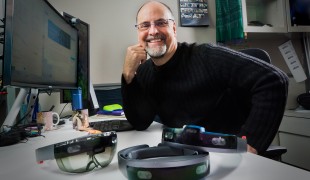- 2751
- 302
- 9
- 10
- 0
- Help Ukraine
About the solution
Macy Long, a recent graduate from Zane Trace High School, gained recognition for her inventive creation aimed at helping people with visual impairments. Her invention was showcased and celebrated at an international science and engineering fair. What Macy designed is a device that you wear on your wrist. It uses vibrations to let the user know when objects are nearby. The closer you get to an object, the stronger the vibrations become. Essentially, it acts like a virtual white cane, helping people navigate around obstacles.
One interesting thing about Macy's invention is that it also assists users in distinguishing between different objects, somewhat similar to how bats use echolocation to navigate in the dark.
Macy's inspiration for making this device came from a desire to offer an alternative to guide dogs and traditional white canes, which can be costly and less accessible. Her device, however, is designed to be affordable, priced at around $60 per device, making it more accessible to a broader range of people. Macy's determination to bring her idea to life led her to learn computer programming in Python. She was inspired by her encounter with a blind pug at a humane society. Her dedication and hard work paid off, earning her a spot at the international science fair, where her invention garnered significant attention and recognition. Macy's innovative device, born out of her desire to help people, has the potential to make a significant impact in the lives of visually impaired individuals.
Adapted from:
https://eu.chillicothegazette.com/story/news/local/2023/06/04/zane-trace...
This solution shall not include mention to the use of drugs, chemicals or biologicals (including food); invasive devices; offensive, commercial or inherently dangerous content. This solution was not medically validated. Proceed with caution! If you have any doubts, please consult with a health professional.
DISCLAIMER: This story was written by someone who is not the author of the solution, therefore please be advised that, although it was written with the utmost respect for the innovation and the innovator, there can be some incorrect statements. If you find any errors please contact the patient Innovation team via info@patient-innovation.com
-
-
326
-
0
-
3920

Blind woman creates mobile app
CAREGIVING
BODY BALANCE: Maintaining body balance
WALKING: Walking
Blindness
Website
App (Including when connected with wearable)
AI algorithm
Restoring mobility
Promoting self-management
Promoting inclusivity and social integration
Maintaining Balance and Mobility
Preventing (Vaccination, Protection, Falls, Research/Mapping)
Raise awareness
Caregiving Support
General and Family Medicine
Ophthalmology
Pediatrics
Japan
-
-
-
223
-
0
-
2220

Chun Yu inspired by his blind uncle's struggles created Visiontif- wearable AI vision assistant to describe surroundings.
WALKING: Walking
Urban exploration
Blindness
Body-Worn solutions (Clothing, accessories, shoes, sensors...)
Vision problems
Restoring mobility
Managing Neurological Disorders
Promoting inclusivity and social integration
To improve Treatment/Therapy
Preventing (Vaccination, Protection, Falls, Research/Mapping)
Ophthalmology
Physical Medicine and Rehabilitation
Canada
-
-
-
374
-
0
-
4257

Using AI to allow blind people to find familiar faces
COMMUNICATION: Communicating, whether by speaking, listening, or other means
Social interaction
Blindness
5 Senses support devices: (glasses, hearing aids, headphones...)
Body-Worn solutions (Clothing, accessories, shoes, sensors...)
App (Including when connected with wearable)
AI algorithm
Assistive Daily Life Device (to help ADL)
Difficulty communicating with environment
Confusion
Regaining sensory function
Promoting self-management
Promoting inclusivity and social integration
Improving Speech and Communication
Raise awareness
Ophthalmology
Pediatrics
United States
-
 en
en